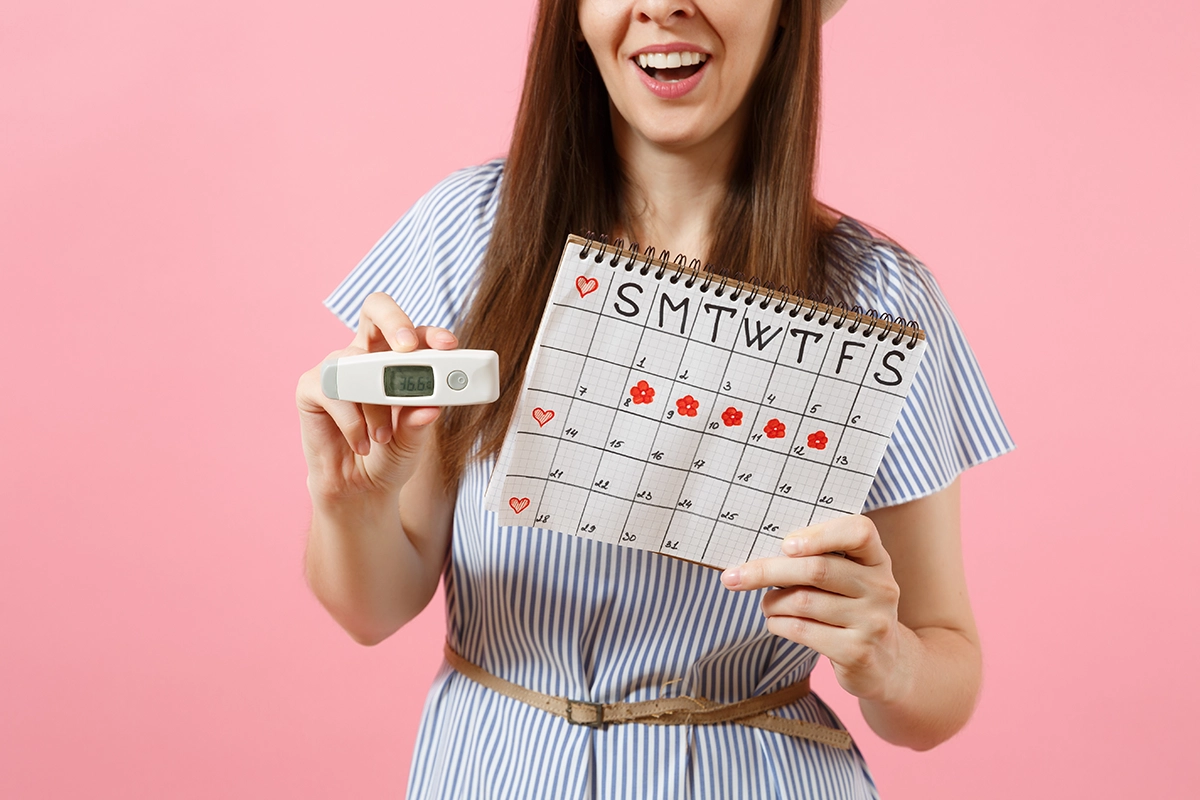How to Know If I Am Ovulating?
Welcome to the UR Crea blog, where we provide you with reliable and important information to help you achieve your dream of starting a family in the best possible way. Today, we invite you to explore the answer to the question: How do I know if I am ovulating? Join us!

The Cycle of Life
The menstrual cycle is a monthly process where female hormones stimulate the release of an egg from the ovary, increase the thickness of the uterine lining in preparation for a possible pregnancy, and then cause the shedding of this lining if conception does not occur, known as menstruation.
Although the average menstrual cycle lasts 28 days, it can vary from woman to woman and from month to month. In teenagers, the cycle can range from 21 to 45 days, while for most adult women, it is usually between 21 and 35 days.
Between days 12 and 14 in a 28-day menstrual cycle, the egg is released from the follicle in the ovary in a process known as ovulation. This event can occur at any time between day 10 and day 21 after the start of a woman’s menstrual cycle.
There are various methods to determine when ovulation occurs, such as home tests that detect luteinizing hormone (LH) levels in urine and tracking body temperature, which tends to rise slightly during ovulation.
Around the middle of the cycle, some women experience pain on one side of the pelvic region; this pain, known as “Mittelschmerz” (which means “middle pain” as it occurs mid-cycle), can be an indicator of ovulation.
A study by the National Institute of Child Health and Human Development found that stress is linked to a decrease in ovulation, conception, and pregnancy in women who have previously experienced failed pregnancies.
Researchers observed that women with higher stress levels had lower production of reproductive hormones necessary to trigger ovulation. This led to the conclusion that stress before pregnancy could interfere with the production of these hormones, thereby reducing ovulation and the chances of becoming pregnant.
Researchers concluded that high levels of everyday stress could affect the production of hormones necessary for ovulation, thus decreasing the chances of conception.
What Are My Fertile Days?
Fertile days are those when a woman has the highest chance of conceiving. To increase the chances of pregnancy, many couples plan to have intercourse around days 11 to 14 of a 28-day menstrual cycle, which is when ovulation occurs.
However, predicting exactly when ovulation will occur can be difficult. Therefore, healthcare providers recommend that couples trying to conceive have intercourse between days 7 and 20 of the woman’s menstrual cycle, with day 1 being the first day of bleeding.
Moreover, having intercourse every other day or every third day can be as effective as having daily intercourse for achieving pregnancy since sperm can survive in a woman’s body for up to 5 days, while a released egg has a lifespan of less than 24 hours. The highest pregnancy rates have been observed when the egg and sperm fuse within 4 to 6 hours after ovulation.
This method is more useful for regular cycles, but if your menstrual cycle is irregular, you can use an ovulation predictor to determine when you are ovulating. These devices detect the presence of luteinizing hormone (LH) in urine and are available over-the-counter at most pharmacies.
Additionally, there are other methods available to help you identify the most fertile times to conceive a baby, which we share below.
Cervical Mucus Evaluation
Cervical mucus acts as a protective barrier for sperm, facilitating its transport to the uterus and fallopian tubes. It undergoes changes throughout a woman’s menstrual cycle, reflecting her readiness for the release of an egg.
At the beginning of the menstrual period, there is no cervical mucus, the vagina is dry, and it appears over time. At its most fertile point, the mucus is slippery, stretchy, and clear like egg white. After ovulation, the vagina dries out again, and cervical mucus may become thick like rubber.
You can use your fingers to evaluate the texture of cervical mucus. Explore the mucus at the entrance of the vagina and touch it with your thumb and index finger. If the mucus stretches when you separate your fingers, ovulation may be near.
Pay Attention to Your Basal Temperature
After ovulation, body temperature rises and remains elevated for the rest of the ovulatory cycle. At the end of the cycle, it drops again. The gap between these two phases is usually less than 1 degree.
You can use a special thermometer to measure your temperature in the morning before getting out of bed. Keep the thermometer in your mouth for 5 minutes or until it indicates it is ready. Try not to move much, as physical activity can slightly raise body temperature.
When the temperature is between two marks, record the lower number. Try to take your temperature at the same time every day, if possible.
Keep a daily record of your temperature on a chart. When observing a complete cycle, you are likely to notice a point where the temperatures are higher than at the beginning of the cycle. This elevation occurs when the temperature rises 0.2 degrees or more above the temperatures of the last 6 days.
Body temperature is a valuable indicator of fertility. After reviewing several cycles, you will be able to identify a pattern and recognize your most fertile days.
Home Ovulation Test
A home ovulation test is a tool that women use to determine the time of the menstrual cycle when they are most likely to conceive.
This test detects an increase in luteinizing hormone (LH) in the urine, which stimulates the ovary to release an egg. Women often use this test to predict ovulation, which is the optimal time to conceive. These kits are available at most pharmacies.
Luteinizing hormone (LH) urine tests differ from home fertility monitors, as these are manual digital devices that predict ovulation by measuring electrolytes in saliva, LH levels in urine, or basal body temperature.
How to Perform This Ovulation Test
Ovulation prediction kits generally include between five and seven test strips. Sometimes it is necessary to perform the test for several days to detect an increase in luteinizing hormone (LH).
The right time to start the test depends on the length of your menstrual cycle. For example, if your normal cycle lasts 28 days, you should start the test on day 11 (after the start of your period). If your cycle is different from 28 days, consult your doctor about when to start the test. Generally, it is recommended to start it 3 to 5 days before the expected ovulation date.
To perform the test, you should urinate on the test strip or dip it into a sample of your urine collected in a sterile container. The test strip will show a color change or a positive signal if an LH surge is detected.
A positive result indicates that ovulation is likely to occur within the next 24 to 36 hours, although this can vary. The instructions provided with the kit will guide you on how to interpret the results.
If you miss testing one day, you could miss an LH surge. Additionally, if you have an irregular menstrual cycle, you may not be able to detect the LH surge.
Before the Test:
– Avoid consuming large amounts of liquids before the test.
– Be aware that certain medications, such as estrogens, progesterone, and testosterone, can affect luteinizing hormone (LH) levels.
How Can This Test Help Me?
– Use the test to determine the time of ovulation, especially useful if you are trying to conceive. In regular 28-day menstrual cycles, ovulation usually occurs between days 11 and 14. For women with irregular cycles, the test can help you identify the time of ovulation.
– It can also help you adjust medication doses, such as those used to treat infertility.
Other Names for This Ovulation Test:
– Luteinizing hormone urine test (home test)
– Ovulation prediction test
– Urine LH immunoassay
– Home ovulation prediction test
– LH urine test
Keep in Mind:
– False positives are rare but can occur, meaning the test may incorrectly predict ovulation.
– If you have difficulty detecting an LH surge or if you do not get pregnant after several months of using the test, consult your provider. You may need the evaluation of a fertility specialist.
What Is UR Crea and How Can It Help If You Have Infertility Problems?
UR Crea Reproductive Medicine has 30 years of experience in reproductive medicine and assisted reproduction services. We offer various treatments tailored to your needs, which is why we carry out a diagnostic protocol, which is the key to helping you.
Our network is made up of a team of specialists in gynecology-obstetrics, reproductive biology, embryologists, perinatologists, anesthesiologists, and nursing staff; all trained in patient care.
We nurture the dreams of those who long to be parents. Therefore, we provide a trustworthy environment based on the ethics and professionalism of our team, who offer personal and humane treatment. Come and meet us!
References:
1. Menstruation and Menstrual Problems: Information on the Condition. Available at: https://espanol.nichd.nih.gov/salud/temas/menstruation/informacion
2. Scientific News: According to an NICHD Study, High Stress Levels Can Delay Pregnancy in Women with a Previous Pregnancy Loss. Available at: https://espanol.nichd.nih.gov/noticias/prensa/102319-estres
3. Identifying Fertile Days for Pregnancy. Available at: [https://medlineplus.gov/spanish/ency/article/007015.htm]
4. Home Ovulation Test. Available at: [https://medlineplus.gov/spanish/ency/article/007062.htm]








